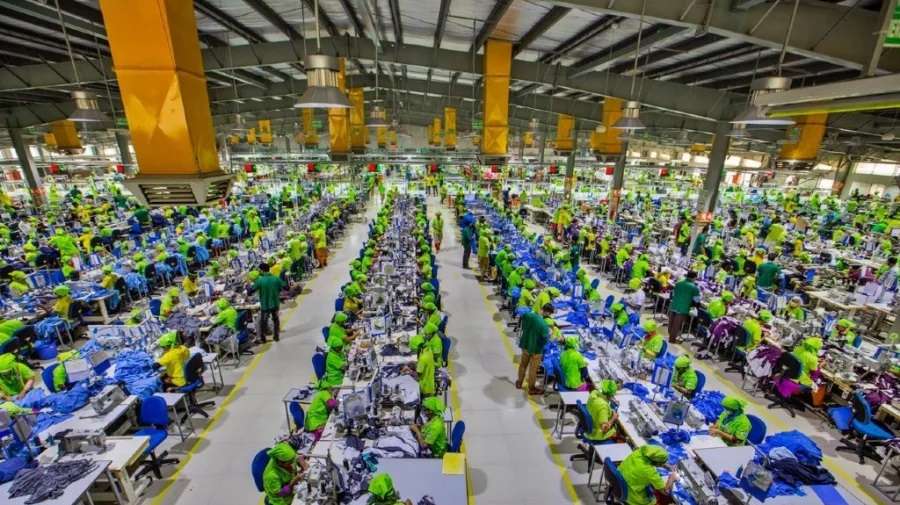FW
Between January and October 2013, readymade shipments by Indian garment exporters to the US grew 6.3 per cent while readymade shipments by Bangladesh jumped 11.4 per cent. Bangladesh’s garment exports increased at a compounded annual growth rate (CAGR) of 16.6 per cent. While that of India rose at a CAGR of just 6.8 per cent in the same period.
Bangladesh has been aggressively pushing garment exports and come up with a slew of policies to facilitate the industry. Among these are uninterrupted power supply and priority at the Chittagong port for shipment. Garment exports contribute 80 per cent of Bangladesh’s total export earnings.
In fact, many sourcing companies have South Asia offices in India, but they source garments from either Bangladesh or Sri Lanka. Apparel companies are tied to low-wage, high-capacity countries like Bangladesh. However, because of recent accidents like a spate of fires and the collapse of garment factories, there was a slowdown in Bangladesh’s garment exports. But since then the sector has shown a remarkable revival. Bangladesh is likely to remain the top destination for new apparel sourcing over the next five years.
Bangladesh's $20 billion garment industry, which took 30 years to build up, is made up of more than 4,500 factories and four million workers.
Garment manufacturers and exporters of Pakistan want government policies to be friendly towards their business. They want the government to take concrete measures for un-interrupted supply of electricity and gas to the apparel industry and to all its supporting sectors. As per them, now they are forced to spend on energy infrastructure like wood and coal boilers that eats into their margins. This is a serious problem. The energy crisis has hampered industrial growth, slowed down GDP and forced industries to relocate, contributing to massive unemployment and disparities. The energy shortfall has also diverted foreign investment away from Pakistan.
Garment exporters complain of delays in sales tax refunds. Facing a liquidity crunch they want zero rating for the textile sector to be restored. The government had withdrawn the zero rating from the textile, leather, carpets, sports, and surgical good sectors. Exporters say this withdrawal at a time when the country has a huge trade gap has resulted in inflation and the devaluation of the Pakistani rupee. They want export-friendly policies to stop the flight of capital and save the industry. The reasoning is that the export volume of Pakistan’s apparel products can be increased if the government takes all stakeholders on board and finalises export policies after consultations.
China’s apparel industry is expected to jump 8.2 per cent, an annualized increases of 10 per cent over the past five years. However, even though exports are a strong, but shrinking. In 2013, exports are expected to increase 6.6 per cent, representing 25.2 per cent of industry revenue. Exports as a share of revenue peaked at 86.8 per cent.
Rising cost of raw materials and higher labor costs have led to a decrease in profits in recent years. In 2013, profit as a proportion of industry revenue was estimated at 6 per cent. By 2018, revenue within the apparel manufacturing industry in China is expected to increase at an average annualized rate of 6.9 per cent. Increasing disposable income in rural areas and Tier II, III cities will be a major driving force behind the industry’s growth. However, trade barriers, currency appreciation and rising raw material prices will challenge apparel manufacturers over the period.
Under the sluggish domestic economic conditions in 2012, consumers became more price-sensitive when purchasing apparels. A number of consumers tended to shop via the net which provides higher discount rates than store-based outlets. In addition, a large number of players collectively opened online outlets in 2012.
Tingley Rubber Corporation has introduced a line of flame resistant, high visibility apparel called: Job Sight FR. It is meant to protect electric utility workers. Other industries that need dual high visibility and FR protection include construction, waste management, telecommunications, transportation and petrochemicals. For over 115 years, US-based Tingley Rubber has been a leader in protective footwear and clothing.
Non flame-resistant high visibility garments such as vests worn over flame-resistant garments can dramatically decrease the effectiveness and protection of flame resistant clothing. It’s important for workers’ protection that the high visibility products conform to the same standards as their flame resistant clothing. In many cases the new Job Sight FR line can replace traditional FR work wear with a product that is both flame resistant and has high visibility, reducing the need for a worker to wear both.
The new Job Sight FR line consists of products that are developed with a revolutionary blend of 55 per cent modacrylic and 45 per cent cotton fibers to maximize wearer comfort and safety. Unlike other high visibility FR products that are heavy, rough and uncomfortable, the high cotton content in the Job Sight FR products make them soft, breathable and comfortable. This new offering features safety vests, T-shirts and sweat shirts.
www.tingleyrubber.com/
Bowing down to pressure from apparel exporters in Bangladesh, the government has asked the National Board of Revenue (NBR) to lower the tax on apparel and textile exports from the existing 0.8 per cent to 0.3 per cent. Garment manufacturers and exporters from the country will enjoy the benefit of the tax reduction till June 2015. The lowering of the tax would cost the NBR about Tk 10 billion in revenue.
Last month, the Bangladesh finance minister had announced the decision to lower the tax rate on apparel exports from 0.8 per cent to 0.65 per cent. However, readymade garment manufacturers and exporters were disappointed with the rate and appealed to the government to lower it further to 0.25 per cent.
During the first five months of the current fiscal, exports of readymade garments from Bangladesh increased by 20.73 per cent. However, the country’s apparel sector has been facing severe issues in recent months due to the political unrest and garment manufacturers of the country have stated that business had slowed down significantly due to severe disruptions in transportations.
Bangladesh’s garment exports to Japan is rising, due to a favorable trade policy and rising demand. In particular there is a strong demand in for denim from Bangladesh. In 2008 , Japan decided to reduce its dependency on China world’s the largest garment supplier. Many Chinese manufacturers were failing to carry out orders because of a shortage of labor, higher wages and continuous labor unrest. Japan started looking for competitive prices. The policy promoted a shift from China to other nations such as Bangladesh. The Japanese government relaxed the ‘Rules of Origin’ on April 1, 2012. Bangladesh knitwear exports to Japan now stand at around $500 million, having gone up from $100 million a few years ago.
Japanese buyers have started outsourcing standard, low-end knitwear and woven wear products. This change in buyers’ sourcing strategy is primarily related to changes in Japanese consumers’ demand arising from structural changes in the job market and changes in the demographic structure of Japan.
Being a member of the least-developed countries' group, Bangladesh has duty-free access to Japan for woven products. The Japanese apparel market is worth more than $35 billion a year and Bangladesh hopes to capture a significant share.
The first edition of Première Vision Istanbul will be held from October 29 to 31, 2014. It will follow the format of all Première Vision shows and be a biannual event. Its aimed at fashion professionals from Eastern Europe and the Middle East.
Première Vision Istanbul, a premium textile show, will present a vast selection of textiles and materials such as fabrics, yarns, accessories and services such as textile designs. The exhibitors have been selected by a committee of adhoc industry professionals, and comprises both Turkish and international companies. Based on the Première Vision show concept, specific services and fashion information adapted to the area's markets will also be established.
Turkey has emerged as one of the most dynamic countries, at the crossroads of Europe and Asia. It is also an important player in the global fashion industry, thanks to a strong textile industry and which is vertically integrated from production of raw materials to garment manufacturing and rich in manufacturing know-how. Istanbul, the capital, has emerged as a regional fashion and market centre for Eastern Europe and Asia.
Première Vision, a subsidiary of the Association Première Vision and the GL Events Group, organises 30 shows throughout the world.
www.premierevision.com/en/Organization/Offices
The collapse and fire damage to garment factories in Bangladesh and poor working conditions of garment factory workers in Asian countries as well as toxic chemicals used in fabric production are driving global brands’ interest in ethical fashion. Their rising interest is also boosting its appeal to a broader market.
Labour unrest due to precarious work atmosphere in Asian factories supplying to some of the big global brands along with pressure being created by vocal campaigns from environmental groups like Greenpeace is leading brands to stop using chemicals, which they say can pollute rivers near factories and threaten the health of workers and consumers. Awareness of these issues has helped ethical fashion start to shake off its reputation as a niche sector, said Olaf Schmidt, organizer of the Ethical Fashion Show in Berlin.
Growing consumer interest is underlined by the number of brands showcasing their wares at the Ethical fashion show at Berlin this year. The number has increased to 116 from 36 when the show was launched two years ago. Last year witnessed 85 exhibitors. The January 14-16 show, part of Berlin fashion week, features brands which use organic cotton, wool and bamboo or alternative materials such as recycled leather and plastic, and pledge to improve pay and conditions for farmers and garment workers.
Recent market research by Mintel shows consumers seek quality over price when shopping for clothes in Britain, France, Germany, Italy and Spain. Mintel said ethical and environmental concerns are strongest in southern Europe.
Ethicalfashionshowberlin.com
Figures from the Department of Commerce's Office of Textiles and Apparel (OTEXA) show that the volume of apparel imports was 2.8 per cent higher year-on-year at 1.85 billion square metre equivalents (SME) compared with the 2.3 billion SME imported in October.
August, September and October are the months when most of the holiday season's merchandise is brought into the country -- booking year-on-year gains of 5.5 per cent, 2.0 per cent and 4.8 per cent respectively in 2013. China remains the largest apparel supplier to the US, with its shipments rising 6.2 per cent to 778 million SME in November, outpacing that of each of the previous three months.
But second-largest supplier Vietnam also ranked as the fastest-growing, a hike of 16.9 per cent year-on-year to 185 million SME. Vietnam has been gaining as both producers and buyers diversify their supply chains by moving some manufacturing from China. <br/>
Vietnam is also buoyed by the expected benefits of the proposed Trans-Pacific Partnership (TPP) trade treaty with countries including Canada and the US.
A stellar performance was also seen by Cambodia, whose shipments surged 11.96 per cent to 78 million SME, despite industrial unrest sparked by poor pay. But India edged up just 1.3 per cent to 62 million SME. Five of the top-ten apparel suppliers to the US saw their imports fall in November, the most notable being third-ranked Bangladesh.
In total, combined textile and apparel imports into the US climbed 5.2 per cent year-on-year in November to 4.452 billion SME. In textiles, shipments rose 6.97 per cent during the month to 2.6 billion SME. While monthly trade data is often volatile, with big swings from one month to the next, a broader year-to-date view shows total US apparel and textile imports were 4.5 per cent higher in the 11 months through November.
Otexa.ita.doc.gov
Bangladesh’s apparel export is reeling under pressure due to continuous strikes and a rise in transportation costs. However, exploring new horizons, the RMG sector is now making inroads in non-traditional markets such as China and South America. This has pushed up growth by over a third in the last year. Exports to Turkey alone more than doubled to over 335 million dollars.
The Export Promotion Bureau reported a rise in apparel exports for the July to November 2013 period, compared to the same period last year. The industry believes that since competition remains intense from rival countries, such resilience is required to grow during tough times. Experts feel that the progress made on the minimum wage last year and in developing safety initiatives supported by major buyers and unions in the aftermath of Rana Plaza are all signs of widespread stakeholder support for the industry in Bangladesh.
It has become important for the RMG industry to invest in innovations and creativity while nurturing new markets along with building on its strengths with longer established customers, in order to ensure sustainable growth and to create new jobs in the sector.












